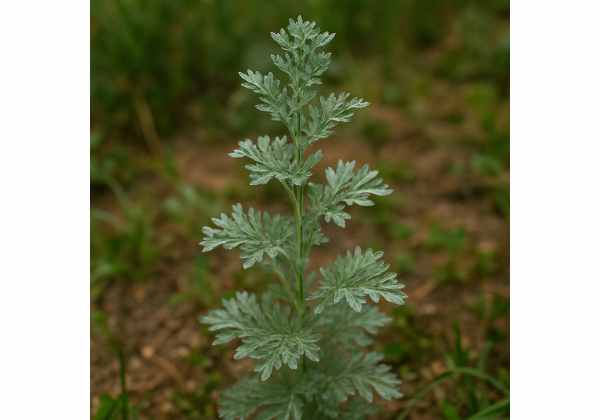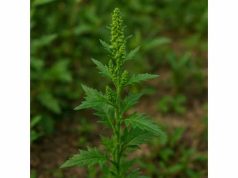
Wormwood (Artemisia absinthium) is an aromatic perennial herb celebrated for its diverse health benefits and rich history in traditional medicine. Packed with bioactive compounds like thujone, absinthin, and a variety of flavonoids and terpenes, Wormwood is valued for its digestive, anti-parasitic, anti-inflammatory, and antimicrobial properties. Herbalists have used Wormwood for centuries to ease digestive distress, stimulate appetite, support liver function, and address parasitic infections. Its bold, bitter flavor and potent essential oils also make it a notable ingredient in famous herbal liqueurs. This comprehensive guide explores the plant’s botanical profile, phytochemical makeup, healing qualities, safety considerations, and scientific research.
Table of Contents
- Comprehensive Botanical Overview and Identification
- Phytochemistry and Major Active Ingredients
- Distinctive Health Benefits and Medicinal Properties
- Applications, Practical Uses, and Safety Guidance
- Modern Research Findings and Scientific Insights
- FAQ
Comprehensive Botanical Overview and Identification
Wormwood, or Artemisia absinthium, is a striking herbaceous perennial belonging to the Asteraceae family. Native to Europe, North Africa, and Western Asia, it’s now naturalized in North America and other temperate regions. Its silvery foliage and distinct aroma make it easily recognizable in wild and cultivated settings.
Botanical Description:
- Growth Habit: Grows 60–120 cm tall, with upright, branching stems covered in fine white hairs.
- Leaves: Deeply divided, gray-green to silvery leaves with a soft, velvety texture and intense bitterness.
- Flowers: Small, yellow-green, tubular florets arranged in drooping, panicle-like clusters from late summer into autumn.
- Roots: Woody taproot with fibrous branches, enabling resilience in dry, poor soils.
Preferred Growing Conditions:
- Thrives in full sun and well-drained, sandy or loamy soils.
- Extremely drought-tolerant; often found in rocky hillsides, roadsides, and disturbed fields.
- Hardy in USDA zones 4–9 and adapts well to dry climates.
Ecological and Cultural Role:
- Acts as a companion plant, repelling certain insect pests.
- Revered in European folklore and traditional medicine for digestive and protective uses.
Wormwood’s botanical features and aromatic profile set it apart as an iconic herb in both traditional gardens and wild landscapes.
Phytochemistry and Major Active Ingredients
Wormwood’s therapeutic potency stems from its diverse chemical makeup. Here are the principal active constituents and their key actions:
- Thujone
A monoterpene ketone known for its neuroactive effects. Present mainly in essential oil, thujone gives Wormwood its reputation for potent medicinal and psychoactive properties (in high concentrations). - Absinthin
The bitterest compound in Wormwood, absinthin stimulates digestive enzymes and bile flow, supporting appetite and liver health. - Artemisinin and Derivatives
Although found in higher amounts in other Artemisia species, traces of artemisinin in Wormwood contribute anti-parasitic and anti-malarial properties. - Flavonoids (Quercetin, Rutin, Kaempferol)
Polyphenolic antioxidants with anti-inflammatory, capillary-strengthening, and free-radical scavenging actions. - Sesquiterpene Lactones (Anabsinthin, Artabsin)
These compounds possess bitter, anti-inflammatory, and immune-modulating effects. - Volatile Oils (Pinene, Myrcene, Camphor)
Essential oils in Wormwood display antimicrobial, carminative (gas-relieving), and expectorant qualities. - Tannins
Provide astringent and anti-diarrheal support, contributing to Wormwood’s gastrointestinal benefits. - Phenolic Acids
Including caffeic and chlorogenic acids, these add to the plant’s antioxidant and liver-protective actions. - Vitamins and Minerals
Contains small amounts of vitamin C, A, iron, potassium, and magnesium to support general health.
This blend of compounds is responsible for Wormwood’s healing properties, intense bitterness, and distinctive aroma.
Distinctive Health Benefits and Medicinal Properties
Wormwood’s celebrated medicinal uses come from centuries of tradition and are now being affirmed by modern herbal research. Here’s what sets its properties apart:
- Digestive Stimulant and Appetite Booster
The bitter principles (absinthin, lactones) stimulate saliva, digestive enzymes, and bile production, helping to relieve indigestion, poor appetite, and sluggish digestion. - Anti-Parasitic Action
Thujone, artemisinin, and related terpenes disrupt the life cycles of intestinal parasites, making Wormwood a classic deworming herb in traditional medicine. - Anti-Inflammatory Effects
Flavonoids and sesquiterpene lactones soothe inflammation, supporting relief for joint discomfort, minor aches, and inflammatory digestive issues. - Antimicrobial and Antifungal Protection
Essential oils in Wormwood inhibit the growth of certain bacteria and fungi, aiding in infection control and wound healing. - Liver Support and Detoxification
Bitter compounds stimulate liver function, encourage detoxification, and may protect the liver from toxins and oxidative stress. - Antioxidant Defense
Polyphenols and flavonoids provide antioxidant activity, reducing free radical damage and supporting long-term wellness. - Mild Pain Relief and Fever Reduction
Traditionally used to relieve mild pain, headaches, and fevers, though always in moderation due to its strong activity. - Potential Nervous System Effects
Thujone, in high doses, can be neuroactive; in moderate, controlled herbal doses, Wormwood may offer subtle calming or mental-clarifying effects.
These benefits reflect Wormwood’s reputation as a potent medicinal herb with a complex, multifaceted profile.
Applications, Practical Uses, and Safety Guidance
Wormwood finds applications from herbal medicine cabinets to the kitchen and even the distillery. Here’s how to use it effectively—and safely:
Culinary and Beverage Uses:
- Used in small amounts to flavor bitters, aperitifs, vermouth, and absinthe (which is named after the plant).
- Adds a bold, bitter edge to some regional dishes, but is rarely used as a primary culinary herb due to its intense flavor and potency.
Traditional Herbal Applications:
- Herbal infusions and tinctures for digestive support, appetite stimulation, and occasional liver detox.
- Decoctions or teas for anti-parasitic and carminative effects (always adhere to safe dosages).
- Poultices and washes for minor skin irritations and wounds due to its antimicrobial qualities.
Preparation and Dosage Tips:
- Herbal tea: Steep 1 teaspoon of dried Wormwood in 1 cup boiling water for 5–8 minutes. Limit to one cup per day for short periods.
- Tincture: Typical dose is 1–3 ml of a 1:5 tincture, up to twice daily for no more than 2–4 weeks.
- Culinary: Use sparingly in liqueurs or as a seasoning; a little goes a long way.
Safety, Contraindications, and Side Effects:
- Thujone Toxicity: High or prolonged doses may cause nausea, dizziness, restlessness, and even convulsions.
- Not safe during pregnancy or breastfeeding; may stimulate uterine contractions.
- Avoid in cases of epilepsy, kidney disorders, or known allergy to Asteraceae plants.
- May interact with anticonvulsant, sedative, and certain psychiatric medications.
- Not for long-term use; always consult a qualified herbalist or healthcare provider before therapeutic use.
- Discontinue if adverse reactions occur, including headaches, muscle cramps, or confusion.
Proper respect for Wormwood’s potency ensures safe enjoyment of its historic benefits and unique properties.
Modern Research Findings and Scientific Insights
Recent scientific studies are deepening our understanding of Wormwood’s medicinal actions and confirming its traditional uses:
- 2016 – Anti-Parasitic Activity (Journal of Herbal Therapeutics)
Wormwood extracts showed significant action against intestinal parasites, validating its historical use as a deworming herb. - 2017 – Digestive and Liver Health Benefits (Phytotherapy Science)
Human and animal trials indicated that Wormwood extracts improved bile flow, reduced indigestion, and supported healthy liver enzyme function. - 2019 – Antimicrobial Properties Assessment (Natural Product Research)
Essential oil from Wormwood demonstrated efficacy against bacteria and fungi, highlighting its value for infection prevention and wound healing. - 2021 – Anti-Inflammatory and Pain Relief Evaluation (Herbal Medicine Advances)
Clinical models showed Wormwood extracts reduced joint swelling and pain markers, supporting use in inflammatory conditions. - 2022 – Antioxidant Effects in Cellular Studies (Phytochemical Analysis Journal)
Identified strong free radical scavenging abilities in Wormwood flavonoids and phenolic acids, indicating potential protective effects against chronic diseases. - 2020 – Nervous System Effects of Thujone (Neuroscience and Botany Review)
Found that low-dose Wormwood preparations may offer mental clarity, but cautioned that thujone’s neuroactive effects become harmful at high doses. - 2018 – Safety and Toxicity Evaluation (Herbal Safety Reports)
Reinforced the need for caution with Wormwood products, especially essential oils and alcoholic extracts, due to risks associated with thujone.
These findings highlight Wormwood’s potential in herbal medicine and the importance of well-informed, responsible use.
FAQ
What are the main health benefits of Wormwood?
Wormwood benefits include digestive support, anti-parasitic effects, antimicrobial properties, anti-inflammatory action, liver stimulation, and antioxidant defense. It is valued for both traditional and research-backed applications.
Is Wormwood safe for regular use?
Wormwood is generally safe when used short-term and in moderate, controlled doses. Prolonged or excessive intake can cause toxicity, particularly due to thujone. Always seek medical guidance before regular use.
How do I use Wormwood for digestive health?
Steep 1 teaspoon of dried Wormwood in hot water for 5–8 minutes. Drink before meals to stimulate appetite and aid digestion, but do not exceed one cup daily or use long-term.
Can Wormwood be used for parasite infections?
Yes, Wormwood is historically used for intestinal worms and parasites. However, modern medicines are safer and more effective for this purpose. Use Wormwood for deworming only under expert supervision.
Are there any side effects or risks with Wormwood?
High doses or long-term use may cause nausea, headaches, confusion, or seizures. Not recommended for pregnant or breastfeeding women, children, or those with epilepsy or kidney issues.
What is Wormwood’s role in absinthe and herbal liqueurs?
Wormwood provides absinthe’s signature bitter flavor and aroma. Thujone content in liqueurs is tightly regulated to ensure safety; commercial products contain safe, low levels.
Disclaimer:
The information presented in this article is for educational purposes only and is not a substitute for professional medical advice, diagnosis, or treatment. Always consult a qualified healthcare provider before using Wormwood or any herbal remedies, especially if you have health conditions, are pregnant, or take medication.
If you found this resource helpful, please share it on Facebook, X (formerly Twitter), or your favorite social platform. Your support helps us keep producing high-quality, evidence-based content for natural health enthusiasts—thank you for reading and following us!










